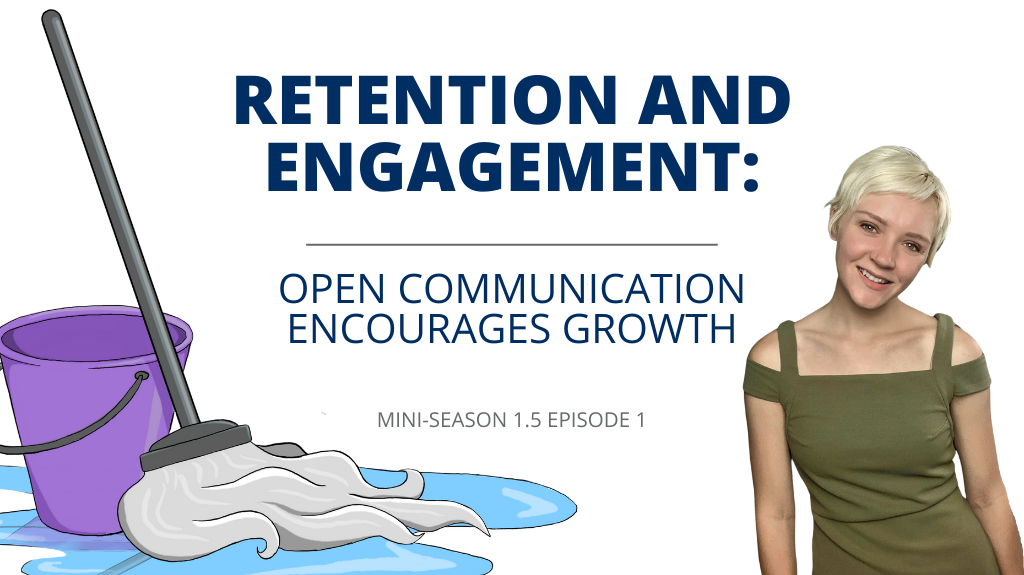The December mini-season will be a break in the usual podcasting content to discuss employee retention and engagement. We’ll be back to the usual content and episode lengths in January for Season 2, which will be built around improving interpersonal connections inside and outside the business.
Click Here To Subscribe On Your Favorite Platform!
Podcast Transcription

Addressing Retention and Engagement
Whether the jobs on your plate have been greatly overwhelming or severely lacking, this year’s dramatic dip in the economy and rising concerns regarding health have creating obstacle after obstacle for the cleaning industry.
One constant concern, especially when it’s so important to keep the budget closely under wraps, has been maintaining retention rates with the staff that we can afford to keep. This means targeting employee engagement and trying to avoid hiring and training new staff during a time when in-person contact has to be kept to a minimum.
How does an employer focus on these things without breaking the bank and what can one even do to improve retention without the usual method of pizza parties, baseball games, and company sports competitions?
You can start with the most basic and fundamental aspect of engagement and retention of all: communication.
We all like to think we’re great at communication but the truth is that nearly all companies have room for growth in that department. You might have realized by now, but periodic email blasts about what the government is doing about COVID-19 and how your company is responding aren’t quite cutting it.
The Elephant in the Room: Feedback
Feedback is the backbone of improvement and growth, but is your feedback channel a two-way street? You can provide feedback to your employees until your blue in the face, but if you only give feedback and aren’t receptive to it return, you’re only doing half the work. Half the work usually means less than half the results if you’re not taking input from the majority of your team.
Did you know that your two-way street of feedback also requires a return trip? If you’re asking for ideas and for feedback you want to also answer the question of what you’re doing with that information. Keep your employees in the look. Let them know you care by explaining what you do with the information they provide. A great idea is to post feedback in a visual place and beside each item, note the action plan for it. If you’re making changes based on the feedback you’ve received, including the people directly involved in the decision-making.
The best part about being a leader is that you’re not expected to have all the answers. You’re there to lead a team that was built because no one person can do the job by themself. Utilize your team to their fullest potential. Uses various methods to communicate ideas and feedback back and forth, such as surveys, roundtables, or a post-it note board.
Lastly, make sure you have buy-in from leaders. They are your first line of communication the ones giving and receiving feedback.
Reshape Your Check-Ins
If you’re 30-60-90 day check-ins and review periods are full of strife, stress, and negativity, you’re doing them wrong.
Think of these touch-points as opportunities for you, your business, and the employee. You don’t approach opportunities with negativity and you certainly don’t approach them once and then never again. A good opportunity should be well-worked out and cultivated so it grows and blossoms.
These are your opportunities to get to know your team members, develop the leaders you already have on board, and keep that communication flowing. So you use them!
Use your 30-60-90 day period as a chance to let your new hire meet more of the team and the faces behind management. At each meeting, give them a chance to meet with someone higher up in the company. If you make it so the CEO stops in for a chat and a coffee after the 90-day meeting, then definitely go for it. Good CEOs want to get to know their teams anyway and this is a chance to make the employee feel important and empowered.
Check-ins don’t stop with the 30-60-90 day review process and they shouldn’t be shoved in a box until a stuffy once a year meeting. Have check-ins every three to six months to keep on top of a career development plan and ensure that feedback (from both sides!) is relevant and actionable. Every employee should have some kind of career development plan, even if they are a part-time cleaner or they have goals that go beyond your business.
Leaders should know their teams. They should know how each person communicates, how they feel regarding their team and their work, and where they want to be in one week, a few months, and a few years. If the first time you know someone wants to quit is during the exit interview, you’re at least one thing wrong. You’re not communicating.
Support your employees and they will support you.

